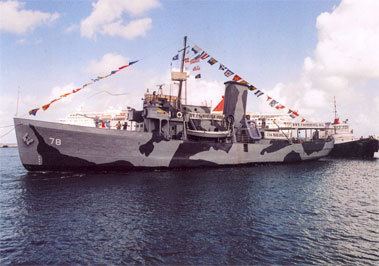Name USS MohawkCGC Laid down 1933 Length 50 m Launched 1 October 1934 Displacement 911,700 kg | Cost $499,800 Commissioned 19 January 1935 Construction started 1933 Weight 1,021 tons Draft 3.73 m | |
 | ||
Sponsored by Miss Ann Gibbons (daughter of the assistant secretary of the treasury, Steven Gibbons) Builder Pusey & Jones Shipbuilders | ||
The fifth US Coast Guard cutter named Mohawk (WPG-78) was built by Pusey & Jones Corp., Wilmington, Delaware, and launched 1 October 1934. She was commissioned on 19 January 1935.
Contents
Active service
She was first assigned patrol and general icebreaking duties on the Hudson and Delaware Rivers, and the outbreak of war found her stationed at Cape May, New Jersey. In accordance with Executive Order No. 89-29 of 1 November 1941, Mohawk was directed to serve as part of the naval forces of the United States. Assigned to North Atlantic escort operations with the Greenland Patrol, where she served for the entire war, Mohawk launched a total of 14 attacks against submarine contacts between 27 August 1942 and 8 April 1945.
On the evening of the 27 August 1942 the fleet oiler USS Laramie (AO-16) was torpedoed while steaming in convoy at the eastern end of Belle Isle Strait. The Mohawk escorted the Laramie into port at Sydney, Nova Scotia on 30 August 1942.
One of Mohawk’s most famous deeds was being the last ship to radio General Dwight D. Eisenhower on the day before the Normandy invasion confirming that the weather was going to be clear enough to proceed. Unfortunately, she hit an iceberg shortly after the message was sent and sustained a hole in her side. After a temporary fix in Greenland, she returned to the United States for permanent repairs to the hull.
Mohawk also survived a friendly fire attack from British planes. While on patrol near Iceland, she was misidentified by British planes, which bombed her, damaging the main deck. She returned to Boston for emergency repairs.
Post war
At the end of the War, she was transferred to her old homeport of Cape May, after her war-time armament was removed, she was stationed at Cape May, from 25 November until 5 January 1946, when she proceeded to New York on special duty. She returned to Cape May on 19 February 1946. On 6 April 1946 Mohawk was ordered to be placed "in reserve, in commission" status, with a skeleton crew, at Cape May, New Jersey.
There was some discussion of converting Mohawk and her sister cutters into lightships but this was eventually deemed to be impractical. On 8 October 1947 Mohawk was ordered to be decommissioned and placed in storage at the Coast Guard Yard.
She was declared "surplus to needs of CG" on 13 July 1948 and was put up for sale. She was sold on 1 November 1948 to the Delaware Bay and River Pilots' Association, and was used as a pilot boat on the Delaware River for more than 30 years.
Mohawk was taken in ownership by Caribbean Transport Lines in lieu of back payment for mooring fees on Staten Island. The ship's plight was shared with the nation via the National Trust for Historic Preservation′s Preservation911 Program in 2001.
Awards
USS Mohawk CGC Memorial Museum
The USS Mohawk CGC Memorial Museum was founded by the Miami Dade Historical Maritime Museum. The ship was berthed in Key West, at Truman Waterfront.
Mohawk was found in a Staten Island scrap yard by Frans Boetes, then president and CEO of Mohawk’s Memorial Museum. She had been there rusting for over 15 years. After some initial repairs, she was towed to Miami, where substantial repairs were made, and on to Key West where she was berthed at the inner quay wall, at the old Navy pier in the Truman Waterfront.
In 2012, the museum was reluctantly forced to either scrap Mohawk or sink her as an artificial reef due to a lack of funds necessary to recover her from her state of disrepair. It was ultimately decided that the most honorable fate was to give her a final duty serving as a veteran's memorial reef in lieu of the scrap yard, where she would have been melted down and sold.
USS Mohawk CGC Veterans Memorial Reef
Starting May 16, 2012, "Mighty MO" was in port at Fort Myers Beach, FL, to be cleaned and getting ready to be scuttled 28 nautical miles off the coast of Captiva Island in its final service as a Veteran's Memorial artificial reef. She was sunk on July 2, 2012.
The Mohawk was the first dedicated veterans memorial military ship reef in the United States of America. The USS Mohawk CGC Veterans Memorial Reef was the brainchild of Mike Campbell with the Lee County Division of Natural Resources, and has made Southwest Florida a new diving destination.
Wreck location: 26°33.075′N 82°43.481′W
